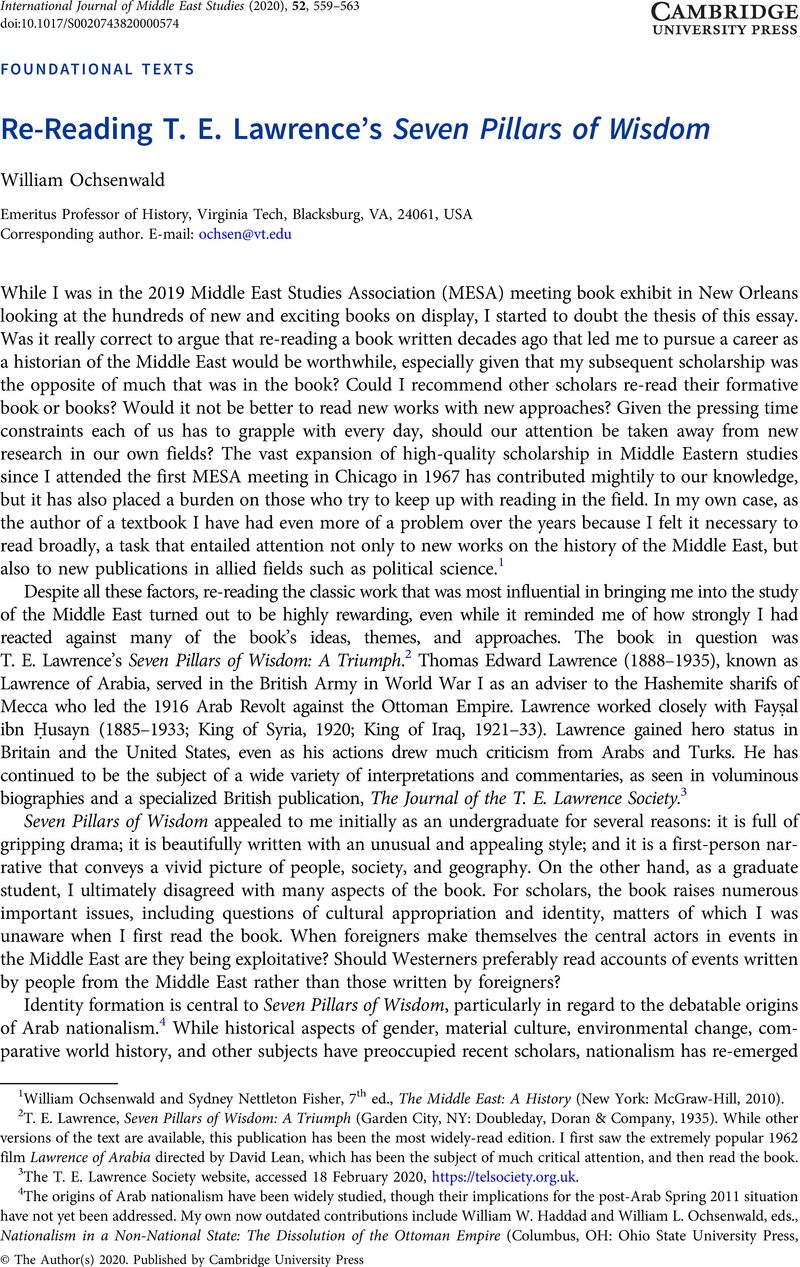Article contents
Re-Reading T. E. Lawrence's Seven Pillars of Wisdom
Published online by Cambridge University Press: 10 July 2020
Abstract

- Type
- Foundational Texts
- Information
- Copyright
- Copyright © The Author(s) 2020. Published by Cambridge University Press
References
1 Ochsenwald, William and Fisher, Sydney Nettleton, 7th ed., The Middle East: A History (New York: McGraw-Hill, 2010)Google Scholar.
2 Lawrence, T. E., Seven Pillars of Wisdom: A Triumph (Garden City, NY: Doubleday, Doran & Company, 1935)Google Scholar. While other versions of the text are available, this publication has been the most widely-read edition. I first saw the extremely popular 1962 film Lawrence of Arabia directed by David Lean, which has been the subject of much critical attention, and then read the book.
3 The T. E. Lawrence Society website, accessed 18 February 2020, https://telsociety.org.uk.
4 The origins of Arab nationalism have been widely studied, though their implications for the post-Arab Spring 2011 situation have not yet been addressed. My own now outdated contributions include Haddad, William W. and Ochsenwald, William L., eds., Nationalism in a Non-National State: The Dissolution of the Ottoman Empire (Columbus, OH: Ohio State University Press, 1977)Google Scholar, and Ochsenwald, William, “Ironic Origins: Arab Nationalism in the Hijaz, 1882–1914,” pp. 189–203, in Khalidi, Rashid, et al. ., eds., The Origins of Arab Nationalism (New York: Columbia University Press, 1991)Google Scholar.
5 Dawn, C. Ernest, From Ottomanism to Arabism: Essays on the Origins of Arab Nationalism (Urbana, IL: University of Illinois Press, 1973)Google Scholar.
6 William Ochsenwald, “Ḥusayn b. `Alī”, accepted for publication in Encyclopaedia of Islam, Third Edition.
7 Two of the many important works on this subject are El-Rouayheb, Khaled, Before Homosexuality in the Arab-Islamic World, 1500–1800 (Chicago: University of Chicago Press, 2005)CrossRefGoogle Scholar, and Arondekar, Anjali R. and Chiang, Howard, eds., The Global Encyclopedia of Lesbian, Gay, Bisexual and Transgender History (Farmington Hills, MI: Charles Scribner and Sons, 2019)Google Scholar.
8 Authors who emphasize the role of India in the history of the Arabian Peninsula include, among many others, Fahad Bishara, Ulrike Freitag, Nile Green, Engseng Ho, Michael Christopher Low, Philippe Pétriat, John Slight, and John M. Willis. The Association for Gulf and Arabian Peninsula Studies is a relatively new scholarly group. See its web site www.agaps.org, accessed March 4, 2020.
9 Ochsenwald, William, The Hijaz Railroad (Charlottesville, VA: University Press of Virginia, 1980)Google Scholar, now superseded by several works including Özyűksel, Murat, Hicaz Demiryolu (Istanbul: Tűrkiye Ekonomik ve Toplumsal Tarih Vakfı, 2000)Google Scholar. Also see Ochsenwald, William, “Hijaz Railway,” in Oxford Bibliographies in Islamic Studies, ed. Voll, John O.. (New York: Oxford University Press), accessed April 16, 2020Google Scholar.
- 1
- Cited by



